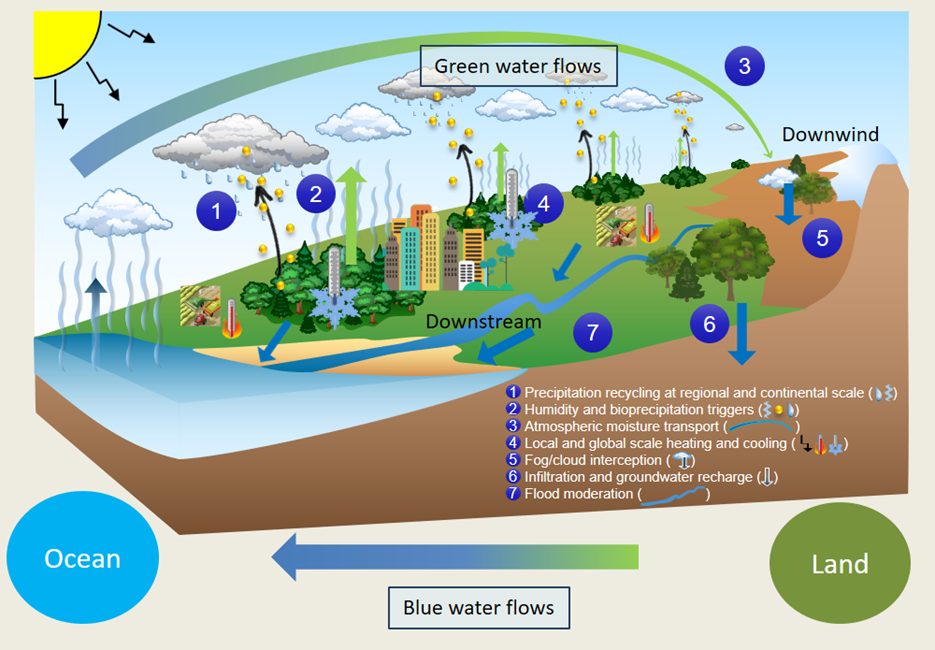Authors: Bart Muys (KU Leuven), David Ellison (Swedish University of Agricultural Sciences SLU), Sven Wunder (EFI)
Clean fresh water has become a key asset of the 21st century, as continued rise in demand and global change induced drought are leading to chronic shortages in many countries. Forests play an essential role in the stable provision of clean, fresh water and related ecosystem services, such as drinking water, protection from floods, erosion and landslides, and climate regulation.
Trees are multi-tasking water engineers, acting as:
- A giant umbrella: Trees have more leaf area than other vegetation, so their canopies are more effective in tempering the erosive forces of rain and creating a more shaded and humid microclimate.
- A water pump: Trees have deeper roots, so they can pump up larger soil water volumes for transport to the leaves, resulting in more biomass production, transpiration and precipitation. A big oak tree transpires up to 1600 litres of water per day. European forests transpire about 400 mm per year, or roughly half the rainfall on the continent.
- An air conditioner: High evapotranspiration from trees and forests ensures a strong cooling effect on their environment, especially in urban heat islands.
- A water tank: Their large litter production and extensive root systems lead to more soil carbon and better soil water infiltration, which improves water retention in the soil and groundwater recharge.
The exact role of forests in the water cycle has been much debated. In older literature forests were described as “sponges”, emphasizing the water buffering capacity of their crowns, roots and soils, moderating flooding and equalizing river flows. But more recently, the multiple benefits generated by green water services of forests (biomass production, microclimate formation, erosion control, atmospheric cooling and precipitation recycling) have been recognized in addition to blue water services (groundwater recharge, water provision for aquatic systems and human needs, Figure 2). As a consequence, the idea of trees as water hogs has been replaced by an integrated approach recognizing the trade-offs between the multiple green water related benefits of trees and their water consumption.
Several principles of water-friendly forest management are well established to manage synergies and tradeoffs in the bundle of waterrelated ecosystem services forests can provide:
- Essential is avoiding deforestation especially in erosion-prone areas, limiting the area of clearcuts especially on steep slopes, and reducing surface run-off and sediment loss. Land degradation and the loss of tree cover worldwide contribute to the loss of soil carbon, infiltration, water retention and groundwater recharge, with the consequence that drying landscapes become more prone to drought and wildfire.
- Restoring forests along riverbanks contributes to water quality and flood resilience
- Optimizing the location of intensive plantation forestry with fastgrowing tree species can temper evapotranspiration where needed and therefore lead to increased water harvest.
- In drinking water production areas, broadleaved forests are preferred over coniferous because their lower time-averaged leaf area yields more water and reduces contamination of aquifers.
- In the context of climate change and increased summer drought, higher thinning intensity stimulates forest vitality and tree growth. The mixing of tree species often leads to complementary soil exploration by roots and may contribute to improved drought tolerance.
- Greening cities with trees cools urban heat islands and mitigates peak flows.
Moving beyond the scale of forest stands and river catchments to the regional and continental scale reveals the breadth of forest-water interactions. Forest canopies massively produce biological particles that serve as condensation nuclei for rain formation. The evapotranspiration by forests recycles rain into clouds (green water flows in Figure 2), impacting wind and weather patterns and creating “flying rivers” over continents that ensure downwind rainfall deep into continental interiors. This helps to sustain rainfall in many of the major crop producing areas of the world. Therefore, forest protection and sustainable management contribute to global social-ecological stability.

Figure. Forests balance blue and green water flows in the landscape.
Green water: water that is intercepted or taken up by plants and returned to the atmosphere by
evapotranspiration.
Blue water: water that is running off or percolates and ends up in aquifers, rivers and lakes.
Numbers 1-7 show the water cycle processes that are enhanced by trees and forests.
(modified after Ellison et al. 2019 and Falkenmark & Rockström 2005) 2